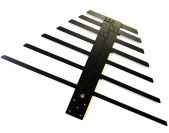Various types of antennas, their function and the benefits
Corps
A VHF (Very High Frequency) Mobile Commercial Band Antenna is specifically designed to operate within the VHF frequency range, typically between 30 to 300 MHz. This frequency band is widely used for commercial and professional communication applications, including public safety, transportation, utilities, and industrial operations.
uhf vhf antennas are designed to provide reliable and efficient communication in mobile environments. They are commonly used on vehicles, handheld devices, and other mobile platforms. These antennas are engineered to have optimal radiation patterns, gain, and impedance matching within the VHF frequency range.
VHF Mobile Commercial Band Antenna
Different types of uhf vhf antenna are available, including whip antennas and ground plane antennas. Whip antennas are popular for mobile applications as they are easily mountable on vehicles or handheld devices. They are often made of flexible materials, such as fiberglass or stainless steel, and come in various lengths to accommodate different frequency bands.

Ground plane antennas are typically used in base station applications where the antenna is mounted on a fixed structure, such as a building or a mast. They consist of a vertical element mounted above a ground plane, which enhances the antenna's performance by providing a reflective surface. Ground plane antennas offer higher gain and coverage compared to whip antennas.
UHF SATCOM Portable Antenna:
A UHF SATCOM Portable Antenna is explicitly designed for satellite communication applications operating in the UHF frequency range, typically between 300 to 3000 MHz. These antennas allow users to establish communication links with satellites in the UHF frequency band.
UHF SATCOM Portable Antennas are widely used in military, aerospace, and maritime applications. They are designed to provide reliable and secure communication links for voice, data, and video transmission in remote and challenging environments. These antennas are typically lightweight and portable for easy deployment in field operations.

Several types of UHF SATCOM Portable Antennas exist, including helical antennas, log-periodic antennas, and patch antennas. Helical antennas are compact and offer circular polarization, making them suitable for mobile and handheld applications. Log-periodic antennas have a wide frequency range and can provide gain and coverage across multiple UHF frequencies. Patch antennas are often used in satellite communication terminals due to their small form factor and high yield.
Antenna Preamplifier / Low Noise Amplifier (LNA):
Auhf antenna Preamplifier, also known as a Low Noise Amplifier (LNA), is an electronic device that amplifies weak signals received by an antenna while introducing minimal additional noise to the movement. LNAs are crucial components in communication systems, including wireless communication, satellite communication, radar systems, and sensitive receivers.
The primary function of an LNA is to amplify the received signal from an antenna, increasing its strength before further processing. LNAs are typically placed near the input of a receiver system to boost weak incoming calls and improve the overall sensitivity and performance of the system.
One of the critical characteristics of LNAs is their low noise figure. The noise figure quantifies the amount of noise added to the signal during amplification. Low Noise Amplifiers are designed to have a low noise figure, which is crucial for preserving the integrity of weak signals. LNAs enhance the signal-to-noise ratio by minimizing noise and allowing for better detection and processing of weak signals.








commentaires